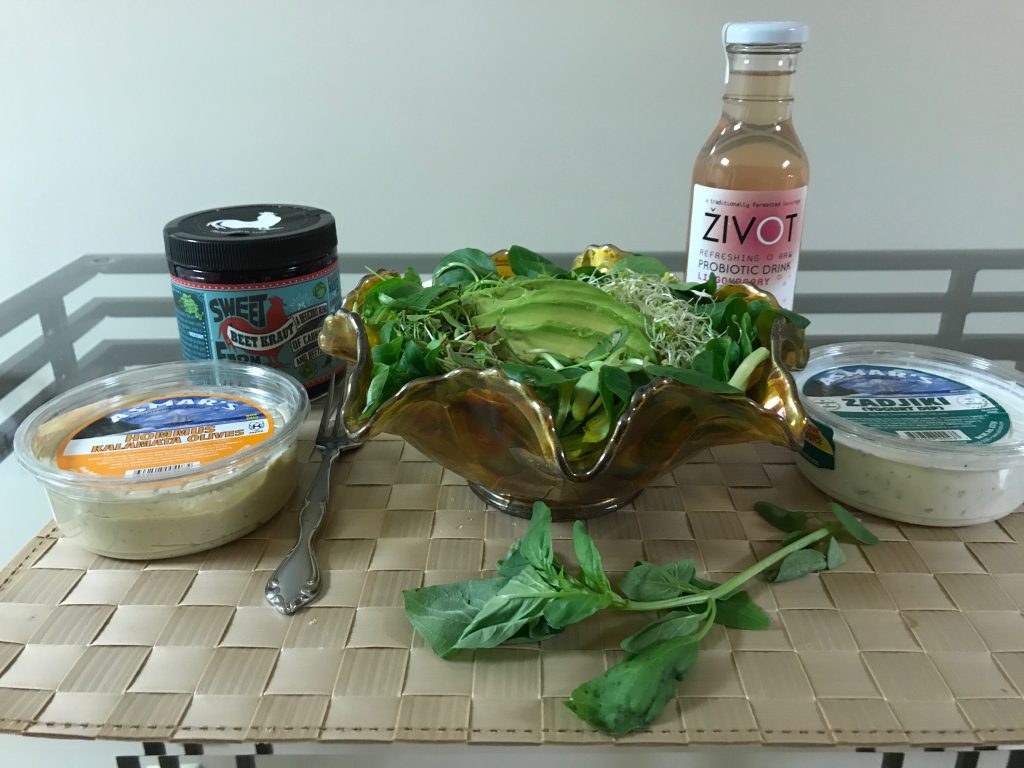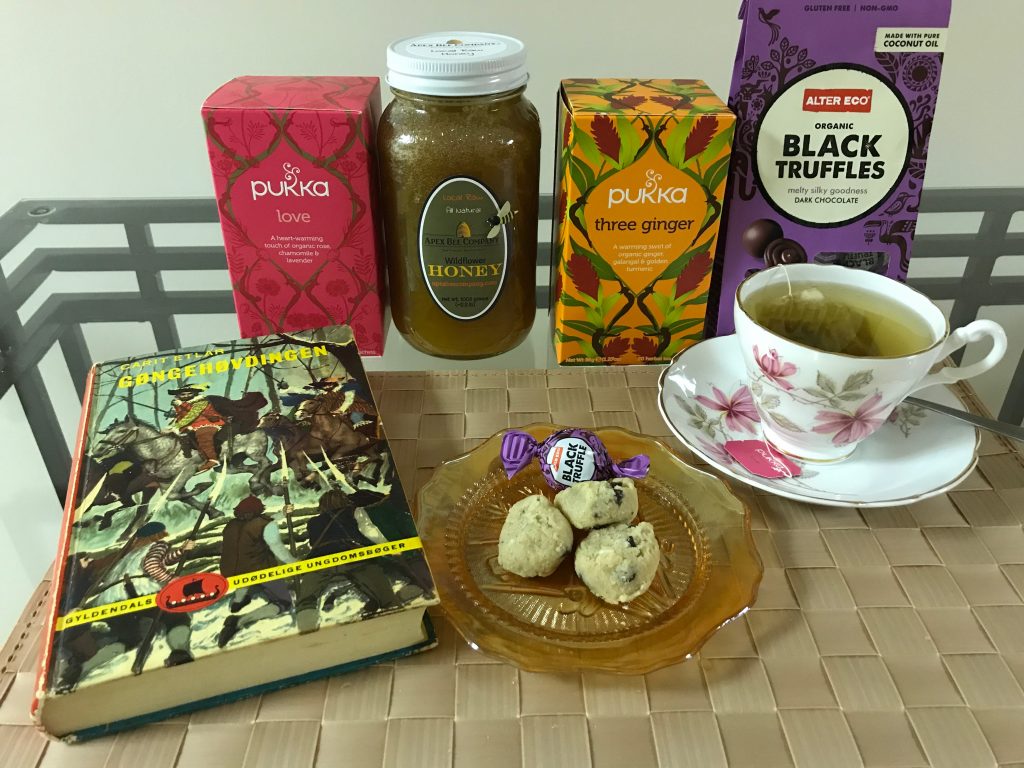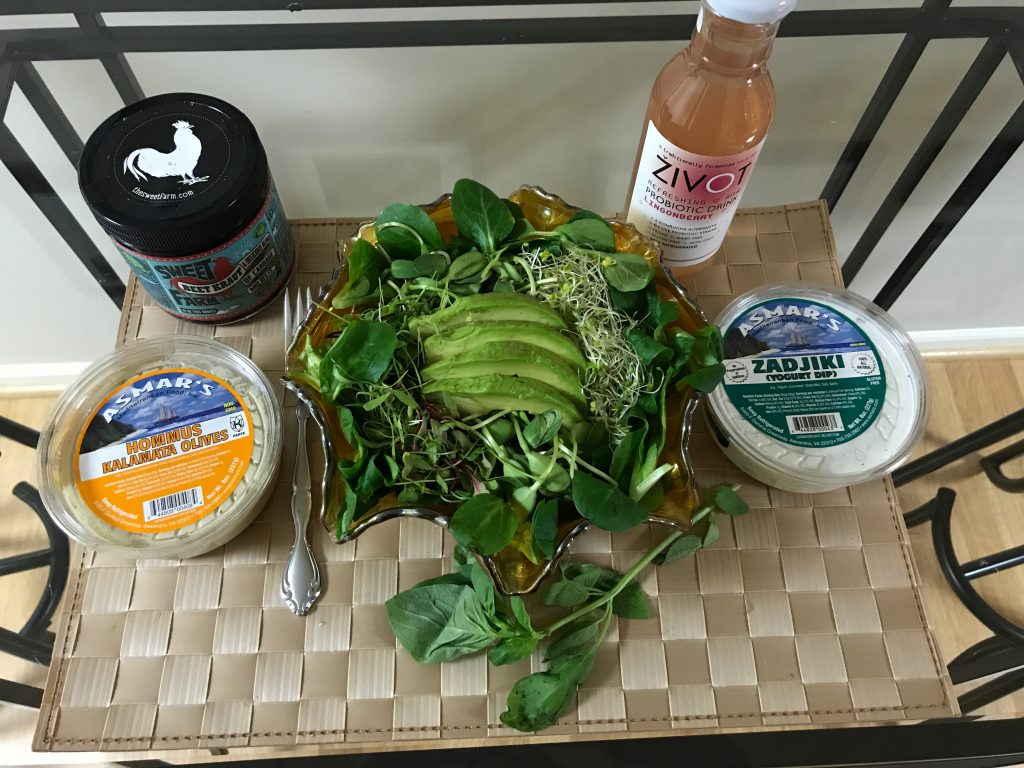How a Pro-Am Ballroom/Theater Arts Dancer Eats
How a Pro-Am Ballroom/Theater Arts Dancer Eats
If you spend any amount of time following dance boards on Pinterest or looking for diet and nutrition advice, you may have run across articles about how professional ballerinas eat, and while I think there is a lot that can be learned by emulating their eating habits, not everything may be applicable or even practicable for those of us who have to work day jobs to support our dance hobbies. Consequently, while I make no pretense of being a nutritionist or dietary consultant whatsoever, I was inspired to share with you a bit of my story, my philosophy on eating and life, and what has helped me to stay in Theater-Arts (1) shape for many years.
A Bit of My Background
At birth, I came out very “healthy”, but apart from that, I was naturally slender until I spent a year abroad as an exchange student with AFS (American Field Service) (2). Before I left, I heard an alternate explanation for the AFS initials, that poked fun at the supposed propensity of exchange students to gain weight while studying abroad, which only made me determined that I wasn’t going to be one of them.
Initially, I had no trouble keeping the weight off. My host father didn’t speak English and insisted that I speak their language instead, and since I was shy, I was nervous about asking for more of something at the dinner table, because my vocabulary was very limited at first. I recall one incident, in particular, where we were having pork roast and potatoes with some “brown sauce” and red beets. My host mother asked me how many potatoes I wanted, and I told her, “One,” thinking she meant a baking-sized potato. She looked at me in surprise and said, “Really? Well, we’re each going to eat about ten.”
I couldn’t imagine how they could put away so many large potatoes. Then when she showed me how small each potato was, I realized I should have asked for a dozen. By that point, however, I was too embarrassed to ask for more, and I didn’t know how to without using English.
Within three months, though, I was pretty conversational in the language of my beloved host country, and by the following spring, I had decided that my time there was limited and to stop worrying about gaining weight and just enjoy every aspect of the study abroad experience, including the food, which meant eating generous portions of potatoes and gravy (since my host-father was a self-styled kartoffelavler) (3), as well as wienerbrød (4) to go along with coffee or, in my case, tea. Sometimes, I would get home from school, and my host father would have gotten off work early. He would ask if I wanted some ice cream, and how could I say, “No,” to that? Then he would come back with two waffle cones piled high and say, “I think we should try some flødeboller (5) with it,” and then he’d slap a flødebolle (singular) or two on top of the ice-cream cones. The result was that, by the end of my stay, I had ballooned to a size 4.
Now before you judge me for that last statement, I am well aware that, for many women, size 4 might be their ideal size, or perhaps even too small. The truth is, though, that we are all built differently, so what is healthy for one person might not be healthy for you. In my case, I have a very small frame, and size 4 was definitely overweight for me.
At any rate, when I returned home, I stopped overindulging, and within a year, I was back to my normal weight and size. In the decades since that first study abroad experience, the weight has stayed off. I don’t credit it to any particular diet, but just to a desire to be healthy. And even though, in the intervening years, I didn’t quite fulfill one of my childhood fantasies of becoming a principal at ABT, when I eventually discovered ballroom dancing, my healthy lifestyle, along with my ballet training and my coach at GQ Ballroom, enabled me to go into Theater Arts dance, where I still get to partner at a high level and go airborne.
There were times, several years ago, when I did occasionally succumb to peer pressure to limit my fat consumption. Ultimately, however, I loved my avocados (6) too much, and a nutritional consultant also clued me in early to the touted benefits of coconut oil (7). I also went through a vegan phase for a while, during which time I did a lot of reading to try to ensure I was getting all of my nutrients, including complete proteins. However, I did another year of study abroad during college, and it became too cost-prohibitive to eat vegan on my student loans; so I gradually reintroduced meat into my diet.
My Goals for Eating and Being Healthy in General
With so many dietary philosophies out there, from the “Mediterranean Diet”, to the “Paleo Diet”, to the “Eat-Clean” Diet, and more, it can be difficult to know which is the right one for you. Moreover, while each probably has its merits, it may be that any one approach is impracticable to follow strictly, unless you have to for medical reasons, which is why I now take the following approach instead:
1. Read, read, read, and talk to your healthcare professional. I have always enjoyed reading about nutrition and diet, and I like to be educated about what is trending right now. I don’t follow any one plan, however. Instead, I read something and say, “I think I would like to include a little more of that in my diet,” or, “Maybe I should do less of that,” and I discuss any concerns with my doctor.
2. Pay attention to how your body reacts to different foods. If I feel like something I’m eating is causing me physical pain or distress, I feel like maybe my body is trying to tell me something, and I see if I can get the same nutrients from something else. So, for instance, if I noticed that I got a headache after eating something, I might do some research to see if something I ate might have been a factor, and then I might make changes to my diet accordingly, after seeking the advice of a medical professional.
3. Stop eating when you are full. Eating too much is uncomfortable, and I don’t like pain; so as a rule, I make a point to recognize when I am full, and stop. I also find it hard to dance when I’m overly full.
4. Try to avoid stress and negative emotions. When I have had stress, I have actually tended to lose weight, but I think that is because, instead of stress eating, I tend to eat less. I have read, though, that for some people, elevated cortisol (8) levels from stress might contribute to weight gain. Even if I personally don’t gain weight when I am experiencing stress, I still don’t like the way that it makes me feel physically, so here are some things that I do to mitigate it:
-
- It may sound cliche, but I try to accept and not to worry about “the things that I cannot change,” like the lane closures and detours that I frequently encounter on the way to work. It is frustrating, but the situation is out of my hands, and being angry about it does not get me to work any faster.
-
- Instead of being jealous and noticing what other people have, that I don’t have, I work on being happy for their happiness and on noticing and being grateful for all of the good things that I do have. The more that I focus on the good things, instead of the “bad”, the happier and less stressed I become.
-
- When seemingly impossible situations do arise, I remind myself that, while it also seems cliche, as my mother always loved to say to me, “This too shall pass,” and that things never look as bad in hindsight; so I have faith.
-
- I try to take some time out for something fun, whether it is dancing, reading, going to a movie, or rock-climbing. Did I mention dancing :)?
-
- I try to surround myself with people who are upbeat, because they make me feel upbeat too.
5. Strive to incorporate foods that are anti-inflammatory and may help digestion. There is a saying, that Galen, the Physician, attributes to the Prophet and quotes in One Thousand and One Nights, (9) that goes, “The stomach is the home of disease, and abstinence is the beginning of cure, for the origin of every disease is indigestion…” It’s possible that is an oversimplification, but I feel that it still makes a lot of sense. We always hear that we need to have certain amounts of particular vitamins and minerals in our diet to help our immune system fight diseases and for our bodies to function properly. By the same token, we often hear that there are also foods with chemicals that could lead to inflammation and chronic disease, such as sugar and processed foods, and even some natural foods may be culprits if we have sensitivities to them (10). This is why I try to listen to my body and to find ways to include things that are anti-inflammatory, like turmeric and ginger (11). Good digestion is also important to me, which is why I try to include adequate fiber (12) and some probiotic foods (13), such as cultured vegetables in my routine. After all, you can’t dance very well if your tummy hurts.
6. Eat slowly (14). Sometimes I am in a hurry, or I may have a limited time to eat my lunch at work, but I try to eat at least dinner and, especially breakfast, slowly, because I feel that it helps my digestion, and I actually get to enjoy my food. For that reason, I make time in the morning, at least an hour and a half, to relax and eat slowly, while I read a book or something, in order to give my digestion time to get moving, no pun intended :).
7. Stay hydrated (15). I try to drink water off and on, throughout the day, but I also drink some caffeine-free teas and other low-sugar, water-containing beverages. If I’m dehydrated I don’t last long on the dance floor.
8. Find ways to move. Ballerinas spend hours and hours every day rehearsing, but since I sit at a desk most of the day, I don’t get that level of activity. I have to wait until after work to rehearse with my dance partner. Still, I try to do little things throughout the day, such as take the stairs, walk for a few minutes, keep stretch bands at my desk, and practice dance moves in the bathroom or in the hallway, when I think no one is watching. This helps me to stay flexible and ready for when I do hit the dance studio.
9. Get enough sleep (16).

I feel like, in order to feel and function my very best, I need about nine hours of sleep. If I get any less than that, my brain seems slower; my digestion is off; I look visibly older; and my joints feel stiffer when I go to dance. I realize that, especially if you are a parent with young children or have a demanding work schedule, you may not have the luxury of getting that much sleep, or perhaps you feel you function just fine on less. However, if you try to get the ideal amount of sleep for you, I think you will find that you feel physically better, look younger, may have less trouble losing weight, and perform better at work. Plus, you might have some energy left for-you’ve guessed it-dancing, even if it’s just a dance session in the basement with your kids :).
10. Dance. It seems like conventional wisdom now, that regular exercise, in general, might help the body with weight loss, fighting chronic illness, relieving stress, and improving mood (17). When it comes to exercising, I prefer dancing over going to the gym, because it is fun, and the music takes my mind off of the “exercise” part of it, which helps me to stay more committed to it. Besides, who doesn’t love to “bust out some moves” to a good song :)?
There are some other things that I could address, like trying to eat “organic” and “local”, but I realize that may not be feasible for everyone; however, if you just try to adopt some of the ideas that I mentioned, I think you will be amazed at how you feel, and maybe you will even experience some side benefits like weight loss. Now that you’ve seen how I think about food, it’s time to share with you how I eat.
A Typical Day of Eating
Breakfast
- Berries. I read an article a while back about the wonderful goodness of berries, so I frequently include a bowl of organic, mixed berries as part of my first meal of the day for all of the potential benefits of their powerful antioxidants. Another piece that I have since read, by Nutrition Educator Michael Joseph, delves into their world even further by elaborating on the nutrition content and benefits of 20 different types of berries, reaffirming my commitment to making them a regular part of my diet. (See footnote 18 below for the link.)
- Eggs. I like to have a boiled egg (19) along with my berries, not just to ensure that I am getting some protein, but for all of their other nutrients as well. Another favorite way to eat eggs is scrambled with a bit of curry powder, which has turmeric.
- Chai or Turmeric Lattes. I have made my own Indian-style chai from scratch; however, it sometimes takes more time than I want to spend. There are several instant varieties available, but many of the ones I have seen contain ingredients that I don’t care for, such as sugar and carrageenan (20). Now, I typically have a cup of Blue Lotus Traditional Masala Chai, which i like, because it has none of the ingredients that concern me, and it is Non-GMO-Project-Verified. Alternately, sometimes I will make myself a sort of turmeric latte, for which you can find many recipes online. I like these, because I find them relaxing and feel that they help my digestion.

- Avocado Smoothies. Alternately, on days when I don’t have the above, I like to make an avocado smoothie, with an avocado, fresh lime juice, some coconut milk, ice, grated vanilla bean, and a little bit of raw, local honey.
Lunch at Work
- Curry. It could be Thai or Indian or boller i karry (21), meat or vegetarian, it doesn’t matter. I know how to make my own, starting with grinding whole spices, and have frequently done so. Lately, however, I have been having leftover takeout from some family-owned restaurants that I trust. I like to put the curry over some quinoa or ancient grains that I bring from home. It may sound a little heavy for a dancer’s lunch; but I feel like, done right, the spices (22) are soothing, and the protein leaves me with just the right amount of energy for dancing when I get off work. And, yes, I do eat other foods besides curries. There are some Persian and Afghan dishes that I love, too, and Vietnamese pho with bone broth.
Snacks
- Chocolate. I admit it. I’m a bit of a chocoholic, but I try to make up for it by being picky about my chocolate. I usually like to purchase from small, local chocolatiers or companies that care about real ingredients. One of my favorite brands is Alter Eco. I also like making my own truffles based loosely off of this recipe (23) from Coracao Confections, which is another company that I love.
- Hail Merry Bites. My new favorite are the Chocolate Chip Cookie Dough flavor, but really, you can’t go wrong with any of them. They are made with real, organic, gluten-free, Non-GMO-Project-Verified ingredients, and they don’t even taste healthy. I find they give me just the right burst of energy I need, without a sugar crash.
- Tea. Right now my favorites are Pukka’s Three Ginger and Love, teas. They are both so soothing and yummy, so sometimes I like to have a cup as I wind up my day at work.
Dinner
- Salad. In the evenings, I like to keep my meals a bit lighter, so on weekdays, I typically have a salad made of a base green like mache lettuce (24), paired with sunflower (25) and other micro greens (26), avocado, some sprouts—like broccoli or clover or alfalfa, and maybe another vegetable, such as carrots or red cabbage. Then I like to include a protein, like chicken or eggs. Finally, I might top it with a dab of cultured vegetables, and some hummus or tzatziki or tahini sauce, or a combination thereof.
- A probiotic beverage. Sometimes, I like to have a serving of a probiotic beverage, such as kombucha or kefir or lassi. Be sure to read up on the pros and cons of them and discuss with your healthcare professional before trying.
- Water. Really, I try to drink some water along throughout the day, but I like to have a glass before bed too.
That, ladies and gentlemen, is how I try to eat and stay healthy so that I can dance forever. If nothing else, I hope you will talk to your healthcare professional and try to educate yourself, as well as take steps to reduce stress and get enough sleep; and I hope that, ultimately, you will become a healthier you. Maybe, we at GQ Ballroom will even see you out there on the dance floor.
Disclaimer: None of the information shared here is meant to diagnose, treat, or prevent any illness. It is merely meant as entertainment and as inspiration; so before beginning any diet or exercise regimen, you should always consult your doctor or healthcare professional.
Footnotes:
- If you are not familiar with the Theater Arts category of Ballroom Dancing, think of it as a show style where you are allowed to include any advanced ballet, jazz, or modern dance training that involves pairing with your partner, where the man lifts the woman off the floor. Typically, Theater Arts is performed to a routine choreographed to a specific song, and the costumes may be themed as well.
- Please visit their website if you are interested in participating in an exchange program or hosting an international student: http://afs.org/
- A kartoffelavler is a potato farmer.
- Wienerbrød is a heavenly, flaky Danish pastry. Many people say it is what we call “Danishes” in the U.S., but, trust me, Danishes are nothing like the real thing. Here is the Wikipedia article: https://en.wikipedia.org/wiki/Danish_pastry
- These are another yummy Danish treat. If you have an IKEA (pronounced ee-kay-uh) near you, you might be able to find a version of them there. There are also many recipes online, if you can understand Danish. To read more about them, check out this link: http://floedebolle.com/
- Here is just one link regarding some potential benefits of eating avocados: http://articles.mercola.com/sites/articles/archive/2013/01/17/avocado-benefits.aspx
- I’m sure many of you are familiar with the coconut oil craze right now, so I will leave you to do your own research on the subject.
- Again, I am no expert on the subject, but here is one article on cortisol and weight gain, and there are many more if you search: http://www.todaysdietitian.com/newarchives/111609p38.shtml
- Excerpt From: Richard Francis Burton. “One Thousand and One Nights – Complete Arabian Nights Collection (Delphi Classics).” iBooks. Available through iTunes.
- (10)This is not a comprehensive article, but it addresses the nightshade family, to which some people are sensitive, and mentions some other sensitivities; and it might be a good start for doing your own research: https://holistichealthpath.com/nutrition/nightshade-vegetables-and-inflammation/
- (11)This is a good introductory article on the potential benefits of turmeric and ginger. I recommend talking to your doctor and doing more research to see if including them is right for you and how best to use them. I personally like teas or curries: http://healthyeating.sfgate.com/benefits-ginger-tumeric-4701.html
- (12)Everyone probably knows we need adequate fiber in our diet, but since I am not an expert, here is an article from a reputable source: http://www.mayoclinic.org/healthy-lifestyle/nutrition-and-healthy-eating/in-depth/fiber/art-20043983
- (13)This is a link to an article on the subject: http://probiotics.mercola.com/probiotics-health-benefits.html. If you do your research, there are resources out there for making your own, but my busy schedule doesn’t leave me enough time. Also, I worry I might do something wrong, so I purchase mine. A couple of my favorite brands are Hex Ferments, https://www.hexferments.com/, and Sweet Farm, https://thesweetfarm.com/.
- (14)Here is one article about potential benefits of eating slowly. I have seen other articles suggesting that slow eating does not necessarily help limit caloric intake or the desire for snacking, but I still feel like it is a healthy habit to adopt: https://zenhabits.net/5-powerful-reasons-to-eat-slower/
- (15)There are tons of other articles out there, but Dr. Axe keeps coming up; so here is an article of his on the importance of hydration: https://draxe.com/how-to-stay-hydrated/
- (16)This article talks about the impact of sleep on weight loss: http://www.shape.com/lifestyle/mind-and-body/why-sleep-no-1-most-important-thing-better-body
- (17)These probably seem like common sense, but here are some articles from respected sources: http://www.mayoclinic.org/healthy-lifestyle/fitness/in-depth/exercise/art-20048389/, http://www.webmd.com/depression/guide/exercise-depression#1
- (18)Here is the link for the comprehensive article on berries by Michael Joseph: http://nutritionadvance.com/types-of-berries Here is some additional light reading on the potential benefits of eating berries: http://www.eatingwell.com/nutrition_health/nutrition_news_information/the_total_body_benefits_of_berries
- (19)Here is an article on wonderful eggs: https://authoritynutrition.com/10-proven-health-benefits-of-eggs/
- (20)This article explains why I am starting to be more careful to avoid products with carrageenan: https://draxe.com/what-is-carrageenan/
- (21)Boller i karry is Danish meatballs in yellow curry. I make it the way my værtsmor (host-mom) taught me, but here are a couple of recipes, in case you want to try it: http://www.copenhagenet.dk/CPH-Map/CPH-Recipes-8-10-BollerKarry.asp, http://www.danishnet.com/food/danish-meatballs-curry/
- (22)Here is a link to get you started on learning about some potential benefits of spices. It mentions some of the main ones that I like to incorporate, and there is a lot more information out there, if you just look: http://www.wellnesstoday.com/nutrition/5-spices-that-help-heal-your-digestive-system
- (23)Homemade truffle recipe from Coracao Confections: https://www.youtube.com/watch?v=kfbyKkCIjdc
- (24)http://www.healwithfood.org/health-benefits/mache-lettuce-nutrition.php
- (25)http://markitonutrition.com/sunflower/
- (26)http://www.npr.org/sections/thesalt/2012/08/29/160274163/introducing-microgreens-younger-and-maybe-more-nutritious-vegetables




